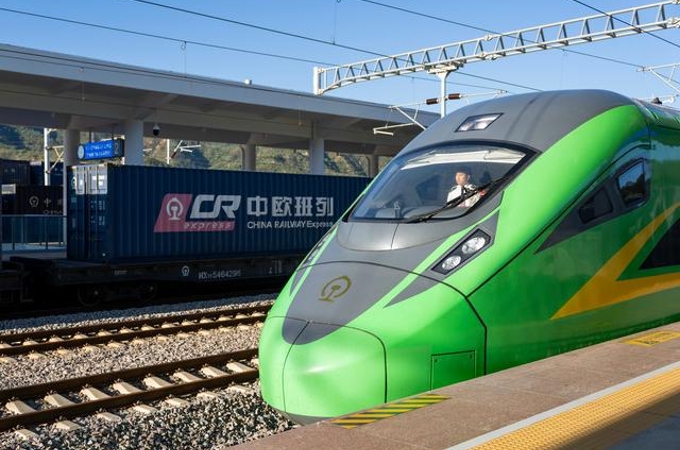Agency's white paper lists Tiangong's scientific feats
Source: China Daily | 2024-12-31 | Editor:Reena
China's Tiangong space station has helped researchers achieve a long list of scientific and technological feats since its completion two years ago, according to the China Manned Space Agency.
The agency published a white paper on Monday in Beijing, showing 34 results of scientific experiments and technological tests that have been conducted onboard Tiangong.
The results relate to several research fields, including life science and biological technologies, observation and analysis on the human body in a space environment, materials science and hydrodynamics in microgravity.
The document outlines multiple world-class achievements obtained by scientists working with astronauts onboard the Chinese space station, including the first germplasm resources of rice developed in space and the first human embryonic stem cells differentiated into hematopoietic stem/precursor cells in space.
The accomplishments also include the world's first cold atom interference gyroscope in space microgravity, the first high-throughput in-orbit microbial control test platform and the longest operation of a space-based water ecosystem, according to the white paper.
Since Tiangong's completion in December 2022, Chinese scientists and technologists have sought to carry out experiments and tests covering 32 academic subjects.
As of Dec 1, a total of 181 science and technology projects have taken place onboard Tiangong, with nearly 2 metric tons of mission necessities having been transported to the space station and nearly 100 kinds of experimental samples and 300 trillion-bytes of data returned to Earth, the document said.
Thanks to Tiangong, Chinese researchers have published more than 500 theses listed in the Science Citation Index, a world-leading thesis index system, and have registered over 150 patents, it added.
The white paper noted that in the near future, Chinese researchers will perform more than 1,000 scientific and technological projects through Tiangong and will continue to offer science lectures and foster international cooperation related to the station.
In-orbit construction of the space station began in April 2021, when China launched the first and central part of the outpost — the Tianhe core module. After that, several groups of astronauts were sent to the module to perform trial operations and prepare for the arrival of other sections.
In the second half of 2022, the Wentian and Mengtian science modules, the two major science components, were launched to dock with the Tianhe module, completing the space station's construction phase.
Tiangong is one of the largest and most advanced structures ever deployed in Earth's orbit and is the only operating space station independently built by a single nation. It now weighs more than 100 tons and is expected to function for at least 10 years.
So far, eight crews have been sent to man the space station, including the incumbent Shenzhou XIX team, which arrived at the outpost in late October.
You May Like
-
UNESCO inscribes Spring Festival on intangible cultural heri...
The United Nations Educational, Scientific and Cultural Organization (UNESCO) on Wednesday inscribed Spring Festival, social practices of the Chinese people in ...
InKunming 2024-12-05 -
Xinhua Headlines: Expo links China with rest of world, promo...
At the 2nd China International Supply Chain Expo (CISCE) being held here from Tuesday to Saturday, a big FARMER BOB statue made a debut at McDonald's booth in t...
InKunming 2024-11-29 -
Nation's resolve to remain firm in fighting desertification
Although considerable achievements have already been made in the fight against desertification, China's top forest and grassland management body has pledged to ...
InKunming 2024-11-29 -
China's sense of responsibility wins applause
As President Xi Jinping wrapped up his trip to Latin America last week, observers noted that the year 2024 has been special for marking the 10th anniversaries o...
InKunming 2024-11-28 -
China's expansion of visa-free countries expected to fuel in...
Numerous listed companies are looking forward to the year-end inbound tourism market, revealing that they have made relevant preparations, as China announced th...
InKunming 2024-11-25 -
China to promote fully digitalized electronic invoices natio...
The State Taxation Administration (STA) announced on Sunday that China will promote the use of fully digitalized electronic invoices nationwide starting Dec. 1.
InKunming 2024-11-25 -
Xi stresses preserving, studying ancient bamboo slips
Xi Jinping, general secretary of the Communist Party of China Central Committee, has stressed sound protection of and in-depth research on ancient bamboo and wo...
InKunming 2024-11-06 -
Huawei releases homegrown HarmonyOS NEXT operating system
Chinese tech giant Huawei on Tuesday released HarmonyOS NEXT, its self-developed operating system built independent of Android architecture.
InKunming 2024-10-25 -
Mastercard ramps up payment services in China
Global payments technology company Mastercard has launched more than 50 bankcard programs in China via its new joint venture as the second foreign player in the...
InKunming 2024-10-25 -
TCM treatment catches interest of new generation
In mid-July, there was a long line in the outpatient hall of Jiangxi Provincial Hospital of Traditional Chinese Medicine in Nanchang. Many of the patients, incl...
InKunming 2024-10-25







